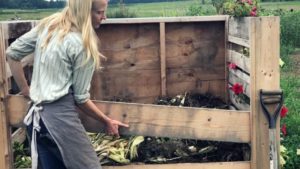It’s really easy to build a compost pile friends. and building a compost pile is kind of like anything where you can keep it super simple, or you can engineer it all day long. And so any route you take is totally valid, I tend to take a really easy route, and use a lot of materials that I already have on hand, I’m going to share with you two different strategies that are both really easy with commonly available materials. The first one, you’re going to have to use your imagination because I’m going to describe my childhood compost file. And so imagine, I found a family with like 40 by 40 garden at my father’s house, and we have this beautiful little compost pile, that’s literally just a pile, and we cleared some space on the edge of the garden. And then we took a drug, a bunch of twigs, there, some this large, some smaller, but we put about six inches of like twigs and other things, really high carbon materials, so that we could keep the air flowing through the bottom, through the bottom of the pile, even as we added material on top of it, and you want it to be right close to the ground because worms are totally your best friends in the compost. And there are countless other micro organisms and macro invertebrates as well that are going to be enjoying and helping the decomposition process and building your compost for you. So the more you can have it close to the earth, the better. But having a little bit off the ground is key for that water drainage as well as air drainage. And so once you have that like six inches of large, large branches, small branches and large twigs, you can start adding materials of your compost and growing up, but we never did it very meticulously or with a great deal of calculation. We just had some excess zucchini, and then we had our old spin bean plants. And then we had this and that. But if you want to ideally, then you just start to layer your materials, your greens, your browns, your carbon, your nitrogen materials, ideally again that that ratio for perfect decomposition for optimal decomposition is to have two thirds of those carbon, those gold dry brown materials. And one third of those nitrogen base those green more wet materials. And from there, you want to just keep them moist. I don’t remember when we first made our compost file, if we actually did spray, like a hose those hose the sticks down. But that would totally be ideal, especially if you live in a place where it tends to get dry and hot in the summer. And even though we live here in the Finger Lakes and zone five, it sometimes will get really hot and dry in the summer where it won’t rain for a few weeks at a time. And so when you’re starting that compost pile, lay those sticks water them really thoroughly. And then if you notice as you’re piling materials on if if it’s not if it’s getting a little dry, feel free, totally valid to bring that hose over and spray down your compost pile. But if you want to do a little bit more serious of composting, I highly recommend this strategy and I’m here at Cornell at the Graduate Student garden and they built these amazing composters. And so I’ll show you a few things about it because with a little more, a little more time. And these were all just found materials that they had here on the farm pallets are on the bottom and on three sides. And then you’ll see on the bottom this there’s a nice water drainage as well as air drainage. And this one this one side is actually boards that can completely remove and be taken out of the top. So if we want to go and whether it’s turning compost more effectively, or getting to the bottom and removing the compost more efficiently, this is a totally brilliant way to keep compost nice and consolidated, easily turned and easily moved in. But as the compost pile grows, you can just add more planks, and I could add planks all the way up to here. So lots of material can be composted in this. And this will easily last four or five years, if not more, depending on your climate, depending on how much material you’re composting, and a lot of other factors. But this is definitely super simple, super easy. And I just love what they’ve done here at the Cornell Sage graduate student gardens and have fun as you develop your own strategies, techniques for composting and if you want to throw any ideas out there run them by me. I’ve seen a lot of composters in my day. And I will be more than happy and in fact honored to share any insights and brainstorm with you and find the perfect compost strategy for your garden.
Friends, rather than selling and shipping seeds, we now share seeds as an embodied gift practice. Learn how to receive seeds from us & here are our FAQs.


